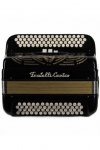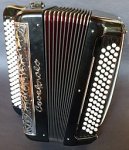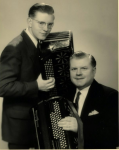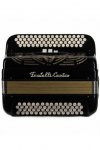AccordionUprising
Well-known member
Saw this linked in a recent CBA discussion. Anybody played one of these free-bass instruments with large buttons on both sides? Pros and cons? More thoughts below the picture.

https://www.musik-center.de/en/fratelli-c-griff-miii-einzelton-58-bass-uberholt-gebraucht.html/
Wish I could stop by and hear it in person. Wonder what the shipping is to Canada? (Please consider not buying it while I lust after it a bit longer. )
)
I guess I'm not familiar with the free-bass terminology. Is "MIII" the mirrored C-system bass on top?
Does it say two treble registers? Curious that it has three switches. Maybe there's options to pick either reed or both? Wonder how they're tuned? Be nice if it was a higher/lower smooth octave tuning. I think I'd prefer that to a big musette.
Wonder what the range on each keyboard is? I've wanted a free-bass with a deep bass range, most I've tried have been rather "thin" on the bass side.
The large bass buttons sure look odd. Might be nice to have them match the right side like this, or could require you to move your left hand too much. Any thoughts? I suspect it would make it hard to re-sell, since it's unusual.
Again, wish I could try it out. Tempting. I might contact the dealer if I can get my questions in order. Any suggestions of what I should ask about it?
PS. Hi all, haven't been by in a while. Nice to chat again.

https://www.musik-center.de/en/fratelli-c-griff-miii-einzelton-58-bass-uberholt-gebraucht.html/
Wish I could stop by and hear it in person. Wonder what the shipping is to Canada? (Please consider not buying it while I lust after it a bit longer.
I guess I'm not familiar with the free-bass terminology. Is "MIII" the mirrored C-system bass on top?
Does it say two treble registers? Curious that it has three switches. Maybe there's options to pick either reed or both? Wonder how they're tuned? Be nice if it was a higher/lower smooth octave tuning. I think I'd prefer that to a big musette.
Wonder what the range on each keyboard is? I've wanted a free-bass with a deep bass range, most I've tried have been rather "thin" on the bass side.
The large bass buttons sure look odd. Might be nice to have them match the right side like this, or could require you to move your left hand too much. Any thoughts? I suspect it would make it hard to re-sell, since it's unusual.
Again, wish I could try it out. Tempting. I might contact the dealer if I can get my questions in order. Any suggestions of what I should ask about it?
PS. Hi all, haven't been by in a while. Nice to chat again.




